I'm trying right now to do a text/graphical overlay of the QOpenGLWidget I've created. As you can see I've got the 3D down pretty tight but the 2D overlay using the QPainter is not working properly. Using the QPainter's drawRect function I expect to see a rectangle. Instead I'm getting four arrows.
The pertinent code is as follows:
main.cpp
QApplication a(argc, argv);
QSurfaceFormat format;
format.setProfile(QSurfaceFormat::OpenGLContextProfile::CompatibilityProfile);
QSurfaceFormat::setDefaultFormat(format);
HSIOpenGLQuadViewWidget qvwidget;
qvwidget.setFormat(format);
qvwidget.init();
qvwidget.addPoint(QVector3D(-1, 1, 1), Qt::red);
qvwidget.addPoint(QVector3D( 1, 1, 1), Qt::red);
qvwidget.addPoint(QVector3D( 1, -1, 1), Qt::red);
qvwidget.addPoint(QVector3D(-1, -1, 1), Qt::red);
qvwidget.addPoint(QVector3D( 0, 0, 0), Qt::red);
qvwidget.addPoint(QVector3D(-1, 1, -1), Qt::red);
qvwidget.addPoint(QVector3D( 1, 1, -1), Qt::red);
qvwidget.addPoint(QVector3D( 1, -1, -1), Qt::red);
qvwidget.addPoint(QVector3D(-1, -1, -1), Qt::red);
qvwidget.generateSphere(0.5);
qvwidget.show();
return a.exec();
MyQOpenGLWidget.cpp
void HSIOpenGLQuadViewWidget::initializeGL()
{
// Required by Qt
initializeOpenGLFunctions();
// Creates a 24 bit depth mask
glRenderbufferStorage(GL_RENDERBUFFER_EXT, GL_DEPTH_COMPONENT24, width(), height());
// Sets the OpenGL screen clear color
glClearColor(0, 0, 0, 0);
glEnable(GL_POLYGON_SMOOTH);
glBlendFunc(GL_SRC_ALPHA, GL_ONE_MINUS_SRC_ALPHA);
glHint(GL_POLYGON_SMOOTH_HINT, GL_NICEST);
// Enables face culling
glEnable(GL_CULL_FACE);
glCullFace(GL_BACK);
glColorMaterial(GL_FRONT, GL_AMBIENT_AND_DIFFUSE);
glColorMaterial(GL_FRONT, GL_SPECULAR);
// Somewhere in the initialization part of your program…
glEnable(GL_LIGHTING);
glEnable(GL_LIGHT0);
glShadeModel(GL_SMOOTH);
// Create light components
//GLfloat ambientLight[] = { 0.2f, 0.2f, 0.2f, 1.0f };
GLfloat ambientLight[] = { 2.0f, 2.0f, 2.0f, 1.0f };
GLfloat diffuseLight[] = { 0.8f, 0.8f, 0.8f, 1.0f };
GLfloat specularLight[] = { 0.5f, 0.5f, 0.5f, 1.0f };
GLfloat position[] = { 0.0f, -10.0f, 0.0f, 1.0f };
// Assign created components to GL_LIGHT0
glLightfv(GL_LIGHT0, GL_AMBIENT, ambientLight);
glLightfv(GL_LIGHT0, GL_DIFFUSE, diffuseLight);
glLightfv(GL_LIGHT0, GL_SPECULAR, specularLight);
glLightfv(GL_LIGHT0, GL_POSITION, position);
//glDisable(GL_DEPTH_TEST);
glEnable(GL_PROGRAM_POINT_SIZE);
glPointSize(5);
}
void HSIOpenGLQuadViewWidget::paintGL()
{
glMatrixMode(GL_MODELVIEW);
glPushMatrix();
glLoadIdentity();
// Set the depth test and clear the depth field
glEnable(GL_DEPTH_TEST);
glDepthMask(GL_TRUE);
glClearDepth(1.0);
glDepthFunc(GL_LEQUAL);
glClear(GL_COLOR_BUFFER_BIT | GL_DEPTH_BUFFER_BIT);
drawPoints();
drawSphere();
glPopMatrix();
QPainter painter(this);
QRect rect = this->rect();
float top = rect.y() + (rect.height() * 0.8);
float height = rect.height() * 0.15;
float left = rect.x() + (rect.width() * 0.8);
float width = rect.width() * 0.15;
QPen pen;
pen.setColor(Qt::red);
pen.setWidth(10);
painter.setPen(pen);
painter.setBrush(QBrush(Qt::red));
painter.drawRect(left, top, width, height);
QString textYaw = QString(" Yaw : ") + QString::number(100) + QString("\n");
QString textPitch = QString("Pitch : ") + QString::number(200) + QString("\n");
QString textRoll = QString(" Roll : ") + QString::number(300) + QString("\n");
painter.drawText(left, top + 10, textYaw);
painter.drawText(left, top + 25, textPitch);
painter.drawText(left, top + 40, textRoll);
}
So, the question is, what would be causing the QOpenGLWidget to draw the four arrows instead of a solid red rectangle? Anybody have a clue? Thanks.
